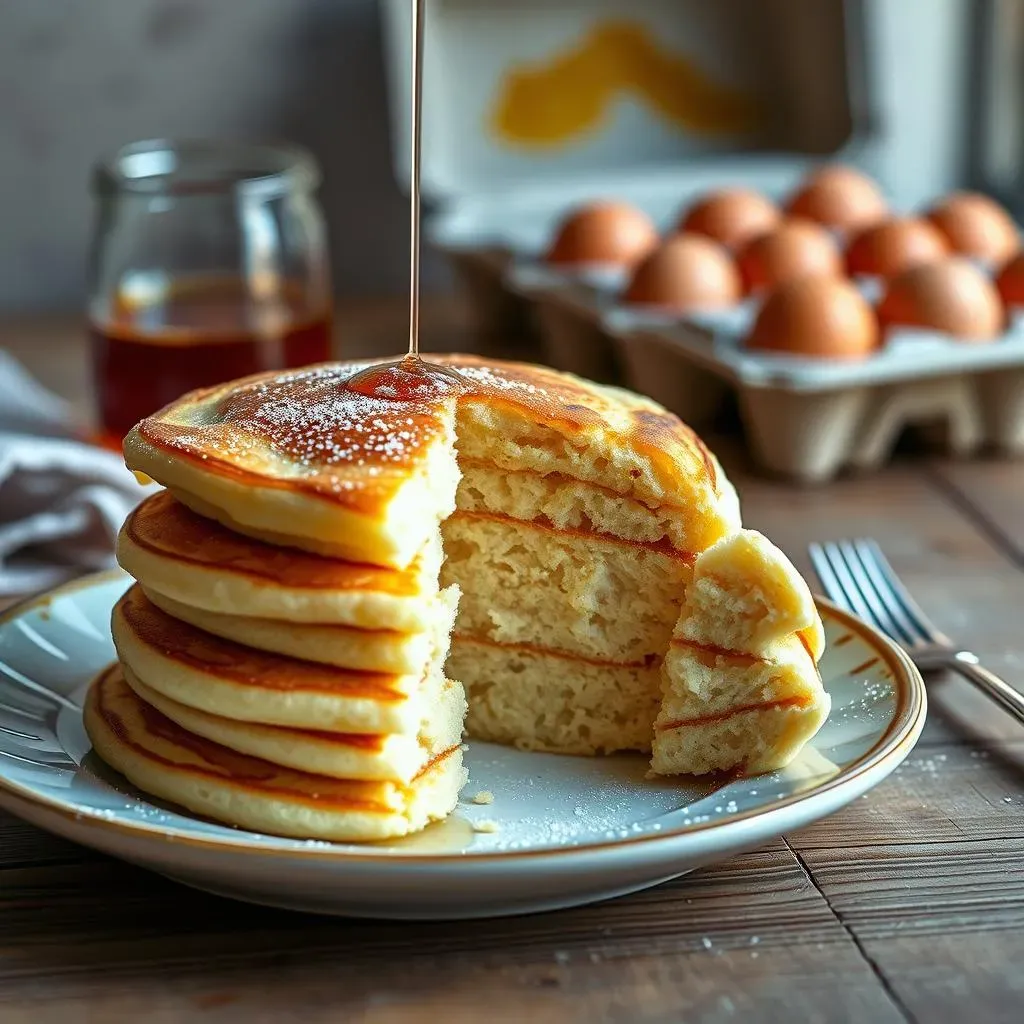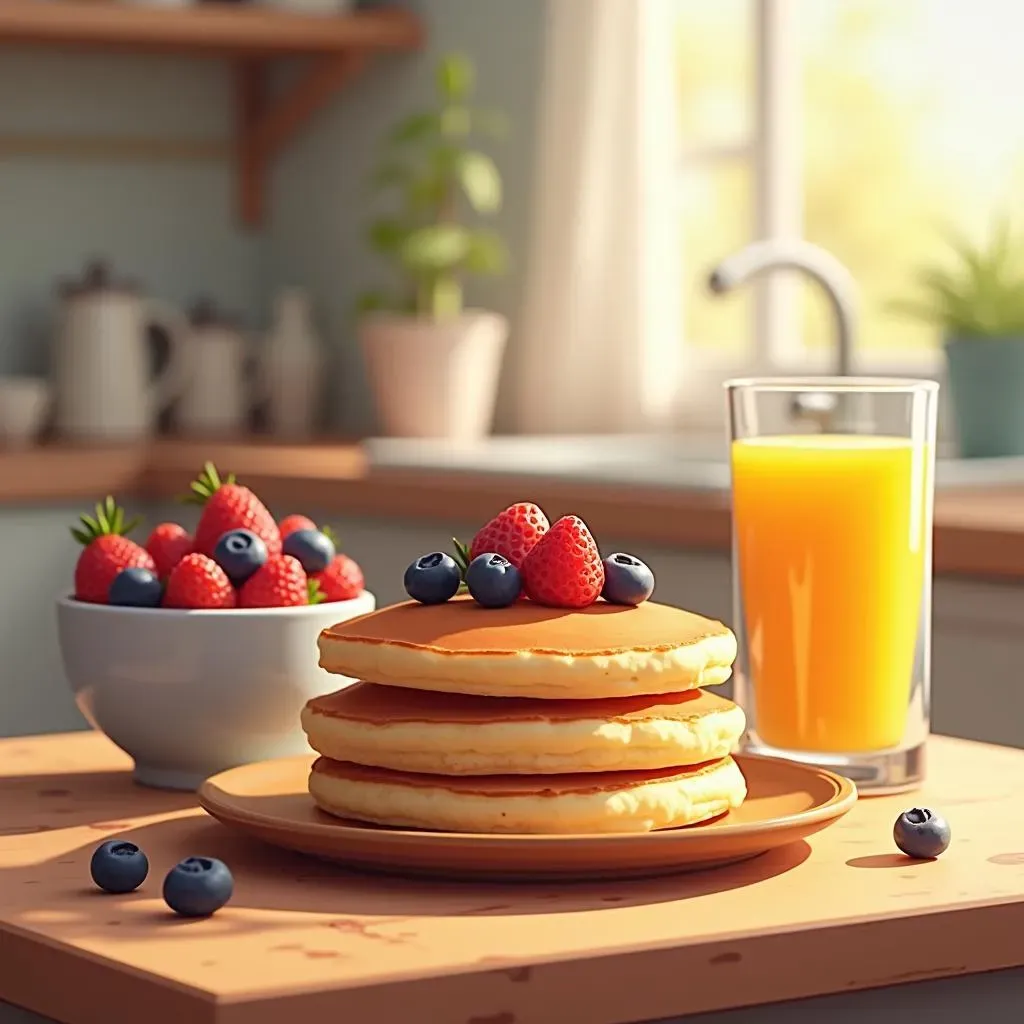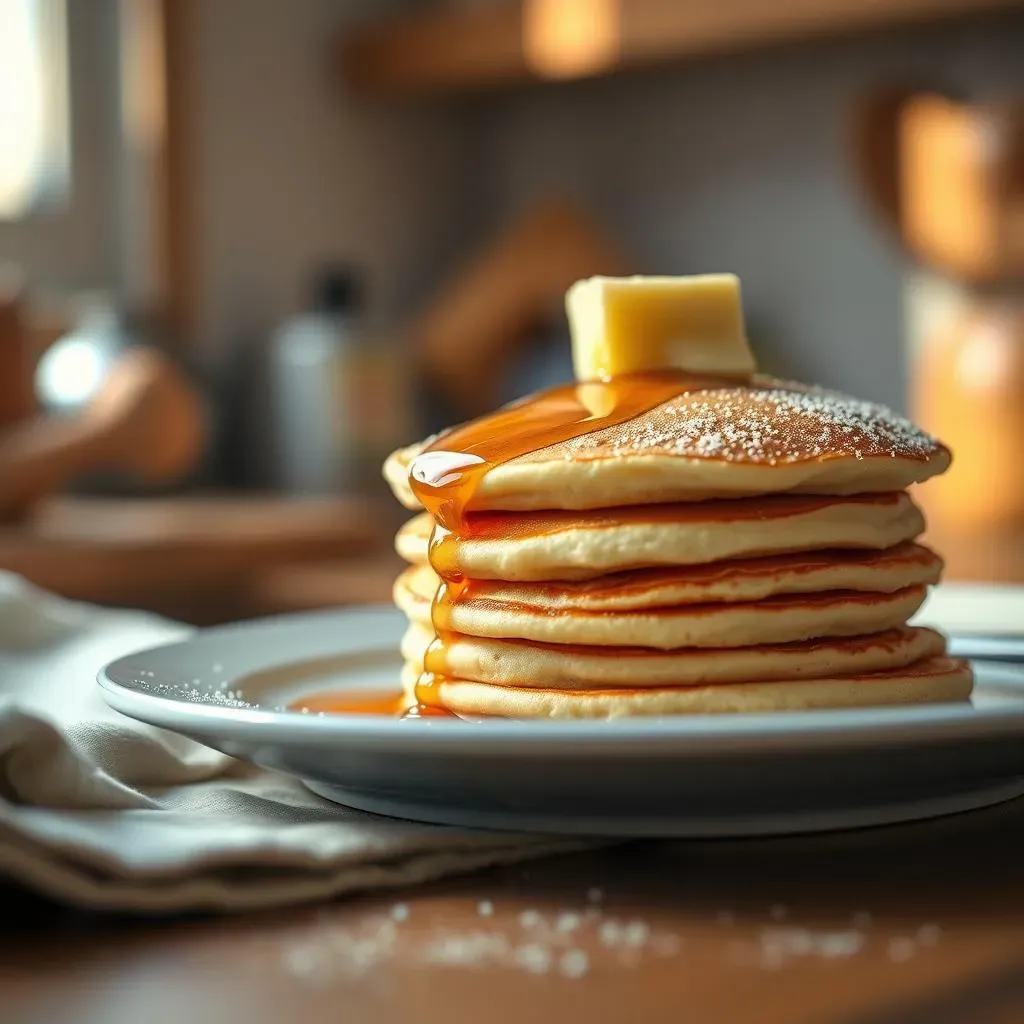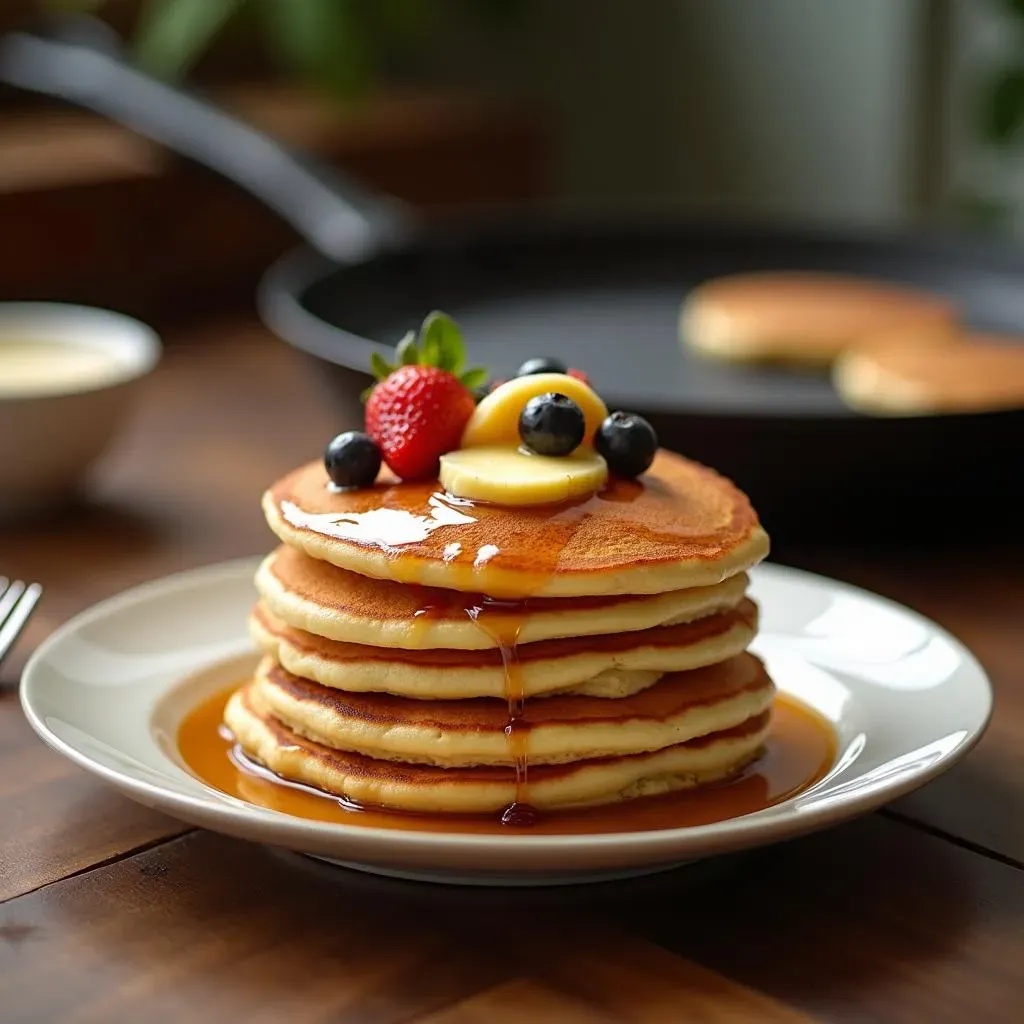Table of Contents
Ever stared at a pancake mix box and wondered, "does pancake mix require eggs?" It's a common question, and the answer isn't always a simple yes or no. Eggs play a big part in the texture and flavor of pancakes, but what happens if you're out or just prefer not to use them? This article will walk you through the role eggs play in your favorite breakfast, and what alternatives you can use to achieve that perfect fluffy stack. We'll explore why eggs are often included in pancake recipes, and what each egg substitute does to the final result. From there, we’ll give you a simple pancake recipe that you can adjust with or without eggs. Finally, we'll cap it off with some tips to make sure you get the best pancakes every single time, whether you're using a mix or making them from scratch. So, get your griddle ready, because we're about to flip some knowledge!
Why Does Pancake Mix Often Require Eggs?

Why Does Pancake Mix Often Require Eggs?
Okay, so you're staring at that pancake mix, and it's telling you to add an egg. Why is that? Well, eggs are like the superheroes of the batter world. They bring a lot to the party. First off, they're the backbone of the pancake, providing structure. Think of it like the frame of a house; without it, everything would just collapse. Eggs also help bind all the ingredients together, making sure everything is mixed nicely. They also add moisture, which keeps your pancakes from turning into dry, crumbly hockey pucks. And let's not forget flavor! The yolks add a richness that you just can't get from other ingredients. So, when a pancake mix asks for an egg, it's not being bossy; it's just trying to make sure you get the best possible pancake.
Does Pancake Mix Require Eggs? Know Your Egg Alternatives

Does Pancake Mix Require Eggs? Know Your Egg Alternatives
The Great Egg Escape
Okay, so maybe you're out of eggs, or perhaps you're just not an egg fan. No worries! You don't have to ditch your pancake dreams. There are plenty of ways to make pancakes without eggs, and they can be just as delicious. Think of it like a cooking challenge, where you get to be a bit of a food scientist. Each substitute brings something different to the table, so you can experiment to find your perfect match. Some of these alternatives are common household items, so you might not even need a special trip to the store.
Here's a quick rundown of some popular egg replacements:
- Aquafaba: That's the liquid from a can of chickpeas. It's surprisingly good at mimicking eggs.
- Vinegar and Baking Soda: This combo creates a chemical reaction that helps with the rise of the pancakes.
- Flaxseed "Egg": Ground flaxseed mixed with water forms a gel that works as a binder.
Aquafaba and Flaxseed Magic
Let's talk a bit more about aquafaba and flaxseed. Aquafaba is like the secret ingredient you never knew you had. It's got this weird, slightly slimy texture, but when you whip it up, it gets all light and fluffy, similar to egg whites. In pancakes, it acts as a binder and adds a bit of moisture, so you won't miss the eggs at all. On the other hand, flaxseed is like nature's glue. When mixed with water, it creates a gel that can hold your pancake batter together. It's also a good source of fiber, so you're sneaking in some extra nutrients.
Egg Alternative | How to Use | Best for |
|---|---|---|
Aquafaba | 3 tablespoons per egg | Light, fluffy pancakes |
Flaxseed "Egg" | 1 tablespoon ground flaxseed + 3 tablespoons water, let sit for 5 minutes | Binding, adding moisture |
Vinegar and Baking Soda | 1 teaspoon baking soda + 1 tablespoon vinegar | Light texture |
Other Alternatives
Don't worry, the list doesn't stop there. You can also use things like mashed banana, unsweetened applesauce, or even plain yogurt as egg replacements. Each of these will alter the flavor and texture slightly, but it's part of the fun of experimenting. For example, banana will add a touch of sweetness and make your pancakes a bit denser, while applesauce will make them more moist. So, the next time you're looking at a pancake mix and wondering about the egg situation, remember that you have options. It's all about finding what works best for you.
Remember, the key is to experiment and see what you like best. Don't be afraid to try different combinations and amounts. You might just discover your new favorite pancake recipe!
How to Make Simple Pancakes (With or Without Eggs)

How to Make Simple Pancakes (With or Without Eggs)
The Basic 3-Ingredient Wonder
Alright, let's get down to it: making pancakes is easier than you think. You can start with a super simple base recipe that only needs three ingredients: milk, eggs, and self-rising flour. That's it! Of course, if you're skipping the eggs, you'll need to swap it with one of our egg alternatives. For the basic recipe, just mix one cup of self-rising flour with one cup of milk, and one egg. Mix until just combined. Don't overmix! Overmixing can make your pancakes tough. If using an egg substitute, follow the guidance on how to prepare them before adding them into the batter.
This basic recipe is your blank canvas. From here, you can add in all sorts of things, like vanilla extract, a pinch of salt, or even a bit of sugar for some extra sweetness. But the core recipe will always be there. Think of it as the foundation of your pancake empire, and you can build on it as much as you want.
Cooking Your Pancakes
Now for the fun part: cooking! Heat a lightly oiled griddle or frying pan over medium heat. Once it's hot, pour about 1/4 cup of batter onto the hot surface for each pancake. You'll know it's time to flip when you see bubbles start to form on the surface of the pancake, and the edges look set. Flip 'em gently and cook for another minute or two on the other side, until they're golden brown. It's like watching magic happen, right? Once they're cooked, stack them up high and get ready to dig in!
One of the biggest mistakes people make is cooking their pancakes on too high of heat. This causes the outside to burn before the inside is cooked through. Make sure you are cooking on medium heat, and your pancakes should turn out perfect every time.
Ingredient | Quantity (with Egg) | Quantity (with Egg Substitute) |
|---|---|---|
Self-rising flour | 1 cup | 1 cup |
Milk | 1 cup | 1 cup |
Egg | 1 | N/A |
Egg Substitute (Aquafaba) | N/A | 3 tablespoons |
Egg Substitute (Flaxseed) | N/A | 1 tablespoon ground flaxseed + 3 tablespoons water |
Adjusting for Egg Substitutes
If you're using an egg substitute, you might need to make some slight adjustments. For example, if you're using aquafaba, you might find that your batter is a bit thinner, so you may need to add a bit more flour. If you're using flaxseed, you might find that your pancakes are a bit denser, so you may want to add a bit more milk to achieve a desired texture. Don't be afraid to experiment a little to get the perfect consistency. It's all about learning and adapting, like any good chef.
The key with egg substitutes is to not be afraid to experiment. Each one behaves a bit differently, so you might need to tweak the recipe slightly to get the perfect pancake. But that's part of the fun of cooking! Once you find what works for you, you'll be a pancake pro in no time.
Tips for the Best Pancakes Every Time Using Pancake Mix

Tips for the Best Pancakes Every Time Using Pancake Mix
Mix Mastery
Alright, you've got your mix, and you're ready to go. But hold up a sec! There's more to it than just dumping the mix and adding liquid. First off, read the instructions on the box. I know, it sounds like a no-brainer, but you'd be surprised how many people skip this step. Different mixes have different ratios, so you need to know what you're working with. Also, don't overmix the batter. A few lumps are okay; they'll cook out. Overmixing develops the gluten in the flour, which will make your pancakes tough and chewy instead of light and fluffy. Think of it like gently folding in the ingredients, not like you're trying to beat a drum.
Another tip is to let your batter rest for a few minutes after you mix it. This allows the flour to fully absorb the liquid, which helps create a more tender pancake. Think of it like letting your ingredients get to know each other a bit before they hit the hot griddle. It's a small step, but it makes a big difference.
Griddle Guidance
Okay, let's talk about the griddle. It's the stage where all the magic happens. First, make sure your griddle or pan is heated to the right temperature. Medium heat is usually the sweet spot. If it's too hot, your pancakes will burn on the outside while the inside is still raw. If it's not hot enough, they'll be flat and sad. You can test the heat by flicking a few drops of water onto the surface. If they sizzle and evaporate quickly, you're ready to go. Also, lightly grease the griddle. You don't need a ton of oil or butter, just enough to prevent sticking. Too much grease will make your pancakes greasy, and nobody wants that.
When you're pouring the batter onto the griddle, try to keep it consistent in size. This helps ensure all your pancakes cook evenly. Once you pour the batter, resist the urge to fiddle with it. Let it cook until you see bubbles start to form on the surface and the edges look set. Then, and only then, should you flip it. Be gentle when you flip, you don't want to deflate your pancakes. A good flip is like an art form, it takes practice, but you'll get there.
Tip | Why It Matters |
|---|---|
Read the box instructions | Ensures correct ratios |
Don't overmix the batter | Prevents tough pancakes |
Let the batter rest | Allows flour to absorb liquid |
Cook on medium heat | Ensures even cooking |
Lightly grease the griddle | Prevents sticking |
Finishing Touches
Alright, your pancakes are cooked, and they look amazing. Now for the best part: the toppings! Don't be afraid to get creative here. Classic butter and syrup are always a hit, but you can also try fresh fruit, whipped cream, chocolate chips, or even a dusting of powdered sugar. The possibilities are endless! Also, don't be afraid to experiment with different flavors in your batter. A dash of cinnamon, a bit of vanilla extract, or even some lemon zest can take your pancakes to the next level. It's like adding your own personal signature to your pancakes.
And finally, enjoy your pancakes while they're hot! There's nothing worse than letting your pancakes sit and get cold. So, gather your family or friends, pour some coffee, and dig in. Making pancakes is a fun and rewarding process, and the best part is sharing them with people you love. You did it! You're a pancake pro!
Wrapping Up: Your Pancake Journey
So, does pancake mix require eggs? The short answer is, it depends! While eggs do contribute to the structure and richness of pancakes, they aren't always essential. You can definitely whip up a delicious batch using egg alternatives like applesauce or even sparkling water. The key is understanding how each ingredient affects the final product. Whether you're sticking to the classic recipe or experimenting with substitutes, the goal is always the same: a stack of fluffy, golden pancakes that makes your morning (or evening) a little bit brighter. So, go ahead, experiment, and find your perfect pancake! And remember, using a high-quality mix like The Great American Pancake Co. can make the whole process even easier and tastier.